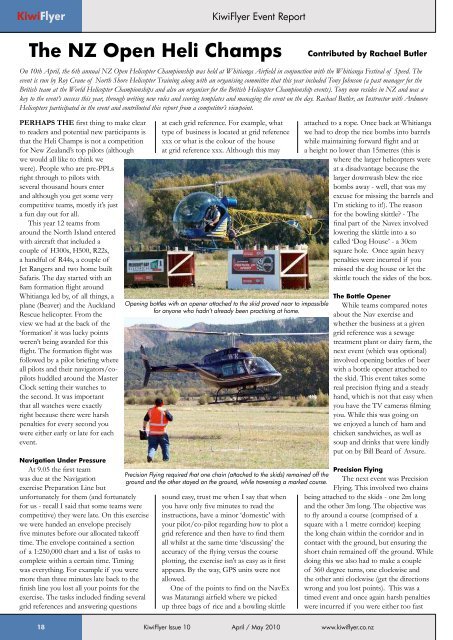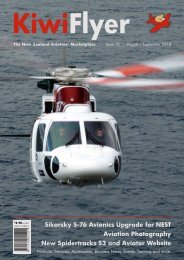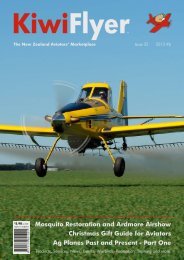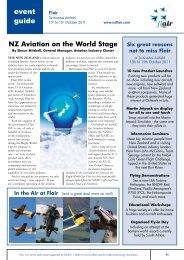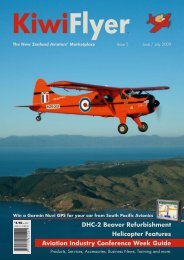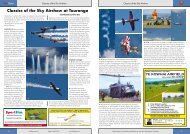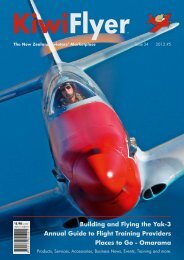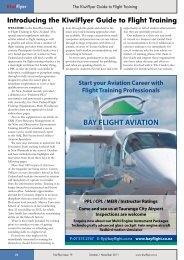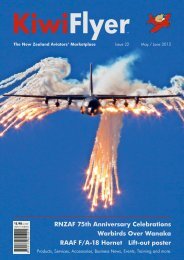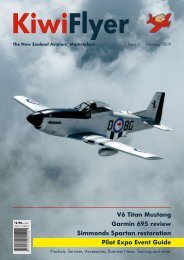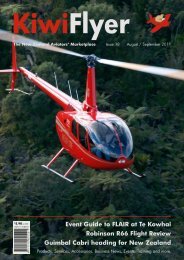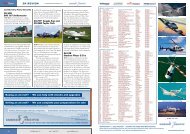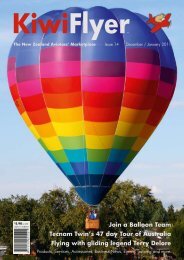Create successful ePaper yourself
Turn your PDF publications into a flip-book with our unique Google optimized e-Paper software.
<strong>Kiwi</strong><strong>Flyer</strong> <strong>Kiwi</strong><strong>Flyer</strong> Event Report <strong>Kiwi</strong><strong>Flyer</strong> Event Report<br />
The NZ Open Heli Champs<br />
On 10th April, the 6th annual NZ Open Helicopter Championship was held at Whitianga Airfield in conjunction with the Whitianga Festival of Speed. The<br />
event is run by Roy Crane of North Shore Helicopter Training along with an organising committee that this year included Tony Johnson (a past manager for the<br />
British team at the World Helicopter Championships and also an organiser for the British Helicopter Championship events). Tony now resides in NZ and was a<br />
key to the event’s success this year, through writing new rules and scoring templates and managing the event on the day. Rachael Butler, an Instructor with Ardmore<br />
Helicopters participated in the event and contributed this report from a competitor’s viewpoint.<br />
PERHAPS THE first thing to make clear<br />
to readers and potential new participants is<br />
that the Heli Champs is not a competition<br />
for New Zealand’s top pilots (although<br />
we would all like to think we<br />
were). People who are pre-PPLs<br />
right through to pilots with<br />
several thousand hours enter<br />
and although you get some very<br />
competitive teams, mostly it’s just<br />
a fun day out for all.<br />
This year 12 teams from<br />
around the North Island entered<br />
with aircraft that included a<br />
couple of H300s, H500, R22s,<br />
a handful of R44s, a couple of<br />
Jet Rangers and two home built<br />
Safaris. The day started with an<br />
8am formation flight around<br />
Whitianga led by, of all things, a<br />
plane (Beaver) and the Auckland<br />
Rescue helicopter. From the<br />
view we had at the back of the<br />
‘formation’ it was lucky points<br />
weren’t being awarded for this<br />
flight. The formation flight was<br />
followed by a pilot briefing where<br />
all pilots and their navigators/copilots<br />
huddled around the Master<br />
Clock setting their watches to<br />
the second. It was important<br />
that all watches were exactly<br />
right because there were harsh<br />
penalties for every second you<br />
were either early or late for each<br />
event.<br />
Navigation Under Pressure<br />
At 9.05 the first team<br />
was due at the Navigation<br />
exercise Preparation Line but<br />
unfortunately for them (and fortunately<br />
for us - recall I said that some teams were<br />
competitive) they were late. On this exercise<br />
we were handed an envelope precisely<br />
five minutes before our allocated takeoff<br />
time. The envelope contained a section<br />
of a 1:250,000 chart and a list of tasks to<br />
complete within a certain time. Timing<br />
was everything. For example if you were<br />
more than three minutes late back to the<br />
finish line you lost all your points for the<br />
exercise. The tasks included finding several<br />
grid references and answering questions<br />
at each grid reference. For example, what<br />
type of business is located at grid reference<br />
xxx or what is the colour of the house<br />
at grid reference xxx. Although this may<br />
Opening bottles with an opener attached to the skid proved near to impossible<br />
for anyone who hadn’t already been practising at home.<br />
Precision Flying required that one chain (attached to the skids) remained off the<br />
ground and the other stayed on the ground, while traversing a marked course.<br />
sound easy, trust me when I say that when<br />
you have only five minutes to read the<br />
instructions, have a minor ‘domestic’ with<br />
your pilot/co-pilot regarding how to plot a<br />
grid reference and then have to find them<br />
all whilst at the same time ‘discussing’ the<br />
accuracy of the flying versus the course<br />
plotting, the exercise isn’t as easy as it first<br />
appears. By the way, GPS units were not<br />
allowed.<br />
One of the points to find on the NavEx<br />
was Matarangi airfield where we picked<br />
up three bags of rice and a bowling skittle<br />
Contributed by Rachael Butler<br />
attached to a rope. Once back at Whitianga<br />
we had to drop the rice bombs into barrels<br />
while maintaining forward flight and at<br />
a height no lower than 15metres (this is<br />
where the larger helicopters were<br />
at a disadvantage because the<br />
larger downwash blew the rice<br />
bombs away - well, that was my<br />
excuse for missing the barrels and<br />
I’m sticking to it!). The reason<br />
for the bowling skittle - The<br />
final part of the Navex involved<br />
lowering the skittle into a so<br />
called ‘Dog House’ - a 30cm<br />
square hole. Once again heavy<br />
penalties were incurred if you<br />
missed the dog house or let the<br />
skittle touch the sides of the box.<br />
The Bottle Opener<br />
While teams compared notes<br />
about the Nav exercise and<br />
whether the business at a given<br />
grid reference was a sewage<br />
treatment plant or dairy farm, the<br />
next event (which was optional)<br />
involved opening bottles of beer<br />
with a bottle opener attached to<br />
the skid. This event takes some<br />
real precision flying and a steady<br />
hand, which is not that easy when<br />
you have the TV cameras filming<br />
you. While this was going on<br />
we enjoyed a lunch of ham and<br />
chicken sandwiches, as well as<br />
soup and drinks that were kindly<br />
put on by Bill Beard of Avsure.<br />
Precision Flying<br />
The next event was Precision<br />
Flying. This involved two chains<br />
being attached to the skids - one 2m long<br />
and the other 3m long. The objective was<br />
to fly around a course (comprised of a<br />
square with a 1 metre corridor) keeping<br />
the long chain within the corridor and in<br />
contact with the ground, but ensuring the<br />
short chain remained off the ground. While<br />
doing this we also had to make a couple<br />
of 360 degree turns, one clockwise and<br />
the other anti clockwise (get the directions<br />
wrong and you lost points). This was a<br />
timed event and once again harsh penalties<br />
were incurred if you were either too fast<br />
or too slow. As with the other events there<br />
appeared to be two schools of thought on<br />
how to approach it. One was “who cares if<br />
it looks pretty, lets just get to the finish line<br />
on time so we don’t get time penalties” so<br />
these guys flew the course strictly to time,<br />
and if the long chain got anywhere near the<br />
ground then that was just<br />
a bonus. The other school<br />
of thought was “let’s go<br />
for accuracy”.<br />
Here’s a tip for any<br />
of you thinking about<br />
competing next year - you<br />
lose more points in time<br />
penalties than anything<br />
else, so the teams that<br />
flew accurately by keeping<br />
the long chain in contact<br />
with the ground within<br />
the 1m corridor and did<br />
their 360 turns in the<br />
right direction didn’t get<br />
many points because they<br />
all took too long. Next<br />
year I’m not going to care<br />
quite so much about what<br />
the long and short chains<br />
are doing and whether<br />
my turns are clockwise,<br />
anticlockwise or in fact<br />
done at all; I’m switching<br />
to the “who cares if it<br />
looks pretty, lets just get<br />
to the finish line on time”<br />
group.<br />
The Slalom<br />
The third compulsory<br />
event was the Slalom.<br />
Once again we were<br />
glad we weren’t the first<br />
team to go as it gave us<br />
a chance to get some<br />
tips from the first teams<br />
through the course. This<br />
event involved lifting a<br />
bucket of water (attached<br />
to the co-pilot) and<br />
manoeuvring it through,<br />
around and into a series<br />
of obstacles. The goal<br />
was to pass the bucket<br />
through all the obstacles<br />
without knocking any of them over and<br />
placing it onto a bullseye painted on a table.<br />
The tricky part about this event is that<br />
the pilot can’t see where the bucket is in<br />
relation to the obstacles and is solely reliant<br />
on the co-pilot telling him/her where to<br />
position the helicopter. The team with the<br />
least time penalties, the most obstacles still<br />
Passing through an obstacle on the<br />
slalom event. The bucket of water is<br />
‘steered’ by the co-pilot.<br />
Buckets also had to be passed through<br />
this gate. Points are deducted for lost time<br />
and spilled water.<br />
standing and the most water left in the<br />
bucket won.<br />
The fourth and final event was the<br />
Fender. This involved a boat fender<br />
attached to a rope (once again attached to<br />
the co-pilot whose arms were getting a bit<br />
tired by this stage). The rope had three<br />
marks on it and the goal<br />
was to place the fender<br />
into one barrel, the<br />
co-pilot then extended<br />
rope to the next mark<br />
while instructing the pilot<br />
on how much to climb<br />
before re-positioning<br />
to place the fender into<br />
the next barrel etc. This<br />
event was also a good<br />
communication test as,<br />
just like the Slalom, the<br />
fender was not visible<br />
from the pilot’s side.<br />
The winners<br />
While the points<br />
were being tallied we all<br />
enjoyed refreshments<br />
and started scheming on<br />
how we could win next<br />
year. Congratulations to<br />
the overall event winner<br />
who was Alan Coubray<br />
and Glen Mulcahy flying<br />
a Safari. Second place<br />
went to Mike Southward<br />
and Rachel Erikson<br />
flying a R22 and third<br />
were John Carter and<br />
Russell Pemberton in a<br />
R44. Mike Southward<br />
also took out the bottle<br />
opening competition with<br />
a NZ record of 8 bottles<br />
in 5 minutes. (Mike<br />
kindly supplied a lot of<br />
the equipment for the<br />
event and quite possibly<br />
acquired some useful<br />
practice in using it first!).<br />
Our Ardmore Helicopters<br />
teams claimed fifth, sixth<br />
and seventh places.<br />
The Heli Champs<br />
is a great event and I<br />
thoroughly recommend it. It is a chance<br />
to meet pilots from around the country<br />
and do things that you wouldn’t normally<br />
get to do. A big thank you to Roy Crane,<br />
Tony Johnson, Hamish Macleod and Simon<br />
Tompkins for organising and running the<br />
event. Ardmore Helicopters will definitely<br />
be back next year.<br />
Contact: Brett Sanders<br />
Bus: 9 299 9442<br />
Fax: 9 299 9458<br />
Mobile: 021 748 984<br />
Address: 168 Kittyhawk Lane,<br />
Ardmore Airport, Auckland<br />
18 <strong>Kiwi</strong><strong>Flyer</strong> Issue 10 April / May 2010 www.kiwiflyer.co.nz If you have an idea to improve <strong>Kiwi</strong><strong>Flyer</strong>, feel free to tell us about it. Email: editor@kiwiflyer.co.nz or phone 0800 KFLYER 19


